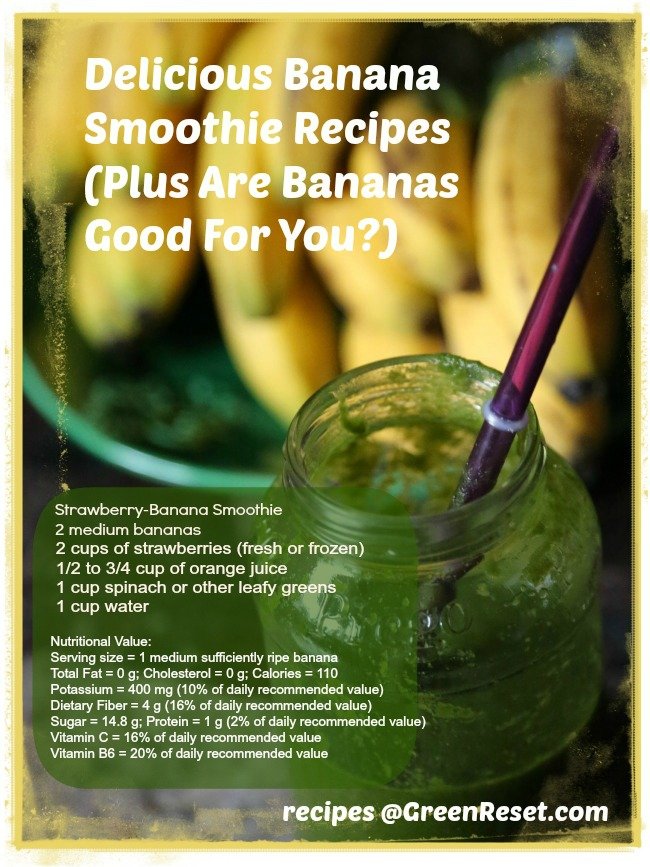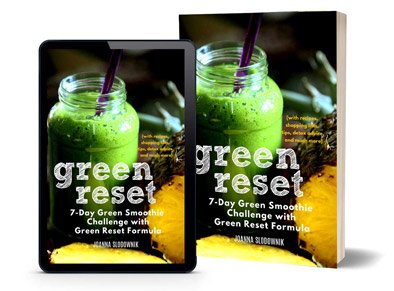Bananas have for long been a staple in many parts of the world. Most people enjoy bananas and banana smoothies. (I have to admit I almost always add at least 2 bananas – and sometimes more) to my smoothies.
They make the smoothies rich and sweet. They are also very filling, and come prepackaged in their own yellow jackets which makes them super-convenient to eat on the go and easy to bring with you on the road.
However, some people claim that they are bad for us because of the sugar and high calorie content, and therefore believe that they should be avoided.
I personally don’t believe this should be an issue for most of us. Even though bananas are high in calories, they are still a healthy food, rich in nutrients and fiber. Still, if you are trying to lose weight or trying to overcome insulin resistance or type II diabetes via diet, then you may want to limit the amount of bananas that you eat. (Also, scroll down to the section on Nutrition, Health Benefits and Will Bananas make me Gain Weight?; plus read my How bad are bananas post here. )
My Best Banana Smoothie Recipes
**Warning**: Just in case you haven’t noticed, you are on a GREEN SMOOTHIES website, so most of the recipes recommend adding some green ingredient – most often spinach – which is the mildest green to add to your smoothies if you are new to them. If you’ve never tried a green smoothie in your life, I encourage you to keep an open mind and just do it! It will not kill you, and who knows, it may help save your life ;-).


Banana Smoothie: Easiest Ever Smoothie
- 2 bananas
- 1 cup water or non-dairy milk
- vanilla extract to taste
Banana Almond Smoothie
- 2 bananas
- 1 cup water or non-dairy milk
- 1 cup almonds
Banana Peanut Butter Smoothie
- 1 1/2 cup almond milk, or any other dairy free milk
- 3 bananas
- 1/2 cup oats (I use uncooked quick oats)
- 1 cup peaches or other fruit, fresh or frozen
- 2 cups mild greens, such as lettuce
- 2 tablespoons peanut butter
- 1/2 teaspoon vanilla butter or extract (optional)
Strawberry Banana Smoothie(with a Green Twist)
- 2 medium bananas
- 2 cups of strawberries (fresh or frozen)
- 1/2 to 3/4 cup of orange juice
- 1 cup spinach or other leafy greens
- 1 cup water
Strawberry Banana Pineapple Tropical Smoothie
- 1/2 pint fresh strawberries (you can leave the stems on!)
- 1/2 fresh pineapple, peeled, cored and chopped
- 2 ripe bananas, peeled
- 1 cup spinach or other leafy greens
- 1 cup water
- 1 cup ice cubes (optional)
Strawberry Kale Banana Smoothie Recipe
- 3 kale leaves, or more (if you are just starting with green smoothies, begin slowly, and keep adding more as you get used to drinking your greens)
- 1 or 2 ripe bananas
- 1 cup strawberries, fresh or frozen
- 1 cup water
- some sweetener such as agave nectar or stevia to taste (optional)
Process in blender until smooth. Serve immediately or freeze until slushy.
Variations
Ice. A lot of smoothie recipes call for ice cubes. Personally, I’m not a fan of adding ice cubes to my smoothies, except sometimes in the summer. Drinking a cold smoothie is not great for our body and digestion.
Non-dairy milk or yogurt. Experiment with various kinds of plant milk or yogurt, such as soy, rice, almond, hemp, etc.
Sweeteners. I find fruit smoothies pretty sweet on their own, so I never add sweeteners myself, but I know a lot of people like to sweeten their smoothies. You can try adding agave syrup, maple syrup, a few dried figs, raisins, or any sweetener that you like.
Tips on How to Select and Store Bananas
Since bananas are picked off the tree while they’re still green, you will often to see them green in the store. Of course, green bananas should not be used in smoothies. The best bananas for smoothies are ripe yellow in hue and with brown spots. Leave bananas to ripen at room temperature. Unripe bananas should not be placed in the refrigerator as this will interrupt the ripening process that will not be able to resume even if the bananas are returned to room temperature.
If you need to speed up the ripening process, you can place bananas in a paper bag or wrap them in newspaper, adding an apple to accelerate the process. You can store ripe bananas in the fridge. Although their peel may darken, the flesh will not be affected. For maximum flavor when consuming refrigerated bananas, remove them from the refrigerator and allow them to come back to room temperature.
You can also freeze unpeeled bananas for use in smoothies. I usually do that when I have a lot of super-ripe bananas that I know I’ll not be able to use before they go bad. When I freeze bananas, I peel them and cut them in half. Then they go into freezer bags until I’m ready to use them.
some people believe that they are bad for us because of the sugar and high calorie content, and therefore believe that they should be avoided.
Banana Nutrition Facts

Serving size = 1 medium sufficiently ripe banana [about 7″ long and 126 grams (0.28 pounds) in weight]
Total Fat = 0 g; Cholesterol = 0 g; Calories = 110
Potassium = 400 mg (10% of daily recommended value)
Dietary Fiber = 4 g (16% of daily recommended value)
Sugar = 14.8 g; Protein = 1 g (2% of daily recommended value)
Vitamin C = 16% of daily recommended value
Vitamin B6 = 20% of daily recommended value
Bananas have a glycemic index of about 55. Compare that to apples, which have a glycemic index of about 38, and to pineapples who have a GI of 66.
The glycemic index measures how quickly the carbohydrates in the food get digested and turned in to blood sugar. This means that bananas get turned in to sugar pretty fast, but a medium banana contains less than 30 grams of carbs so that shouldn’t be a major problem. If you’re on a low-carb diet, though, this could be a problem and it might be a better idea to stick to fruits like blueberries. If you’re trying to overcome insulin resistance or type II diabetes via diet then you may want to limit the amount of bananas that you eat.
Health Benefits of Bananas
Just a brief search online for benefits of bananas produced many results. Here are just a few of them:
Help Bowel Health. Bananas are very rich in fiber content, which helps in curing any bowel-related problems, such as constipation. They can be more effective than laxatives, and much safer too. Bananas also help prevent heartburn. It has an antacid effect preventing heartburn.
Help Lower Blood Pressure. Potassium content in bananas can contribute to reducing high blood pressure and stroke. The presence of potassium also helps in lowering the amount of calcium purged from the body either through urine or in secretions such as sweat, which in turn prevents the occurrence of kidney stones and osteoporosis.
Help Anemia. High in iron, bananas can stimulate the production of hemoglobin in the blood and so helps in cases of anemia.
Help Reduce Stress. Bananas with their high potassium content help our bodies deal with stress. When we are stressed, our metabolic rate rises, thereby reducing our potassium levels. These can be rebalanced with the help of a high-potassium banana snack.
Help Recover from Depression. According one study, many people suffering from depression felt much better after eating a banana. This is because bananas contain tryptophan, a type of protein that the body converts into serotonin, known to make you relax, improve your mood and generally make you feel happier.
I could go on and on about the benefits, but the bottom line is this: bananas are good for you!
Will Bananas Make me Gain Weight?
This is a question that many people ask. Many of people fear that bananas will make them fat which is totally untrue. The reason why people think that is because an average banana has about 100 calories, so for example, if you have 5 bananas a day it is 500 extra calories.
Well, first of all, as already mentioned above, bananas have a very low glycemic index. This is because they are full of fiber. This fiber takes a long time to digest which means that if you snack on two bananas you may very well get 200 calories, but you will also feel full for a couple of hours. Also, most of a banana is water which tends to get retained in the body. All you need to do is sweat it out and it’s gone.
Even the American Diabetes Association states that “Despite being erroneously called “fattening” and too high in sugar, a small banana only contains about 100 calories, which is not much more than a medium apple. Nor should it raise your blood glucose level too high.”
So, consider them safe and healthy for consumption!
For all my blending recipes – including smoothies, soups, nut butters and milks, I use Vitamix. If you don’t already own a VitaMix, I strongly encourage you to check out what this machine is capable of! For more information about VitaMix you can go directly to the VitaMix website. You may also want to read my post about the Best Blender.
I LOVE my VitaMix and highly recommend investing in one if you are ready to make serious changes to your diet. I have had mine for almost 5 years and use it daily!
If you decide to purchase Vitamix – be sure to use Promotional Code 06-004554 to get free shipping.
Questions? Comments? Suggestions?
If you have a favorite recipe, why not submit it here in the comment section of this smoothie recipes blog for others to enjoy too!
I also welcome any comments, questions and suggestions. Thanks!



bananas just make any milkshake taste so good. my post workout shake is just bananas, peanut butter and protein powder. Can drink that the whole day long
My Kids love banana.. Thanks for the information, I should try this at home.
My boyfriend recently started chemotherapy and is looking really thin and has little appetite for things we normally eat so I came up with a recipe to help give him some good fats and protein so he would not end up starving! I have also started drinking these even though I am trying to lose weight. These smoothies leave me totally full and completely satisfy my serious sugar addiction. These taste soooo good! They would be great for kids too.
1 cup unsweetened coconut milk
1 or 2 bananas
1/2 cup raw oats
2 scoops vanilla protein powder
2-4 scoops almond butter
(These measurements vary depending on whether I’m making for one or two of us and how much I’ve already eaten if later in the day.)
Worldwide, there is no sharp distinction between “bananas” and “plantains”. Especially in the Americas and Europe, “banana” usually refers to soft, sweet, dessert bananas, particularly those of the Cavendish group, which are the main exports from banana-growing countries. By contrast, Musa cultivars with firmer, starchier fruit are called “plantains”. In other regions, such as Southeast Asia, many more kinds of banana are grown and eaten, so the simple two-fold distinction is not useful and is not made in local languages..
Most recent short article from our own blog page
http://www.caramoan.ph/cheap-caramoan-tour-package/